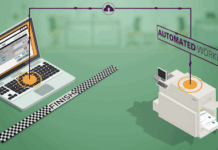According to Jennifer Gvozdek from Omnivex and writing for Digital Signage Today, in 2025 digital displays have evolved beyond their humble beginnings as isolated screens in lobbies, corridors, or waiting rooms, sharing a rotation of basic static content. The age of standalone digital signage is officially over, or at least it should be.
Today, robust digital signage networks with real-time data integration and intelligent content management are commonplace. The power to communicate and engage audiences is at every organisation’s fingertips. From corporate campuses to hospitals, transportation hubs to universities, the power of connected digital signage is unlocking unparalleled value.
From Isolated Screens To Integrated Networks
In the early days, digital signage was little more than a fancy replacement for posters or bulletin boards. Screens were expensive, software options were limited, and network bandwidth was a huge problem. The result was standalone displays that were unable to connect or share content with other devices. Content creation was manual, updates were infrequent, and messaging was inconsistent.
Fast-forward to 2025, hardware prices have plummeted, and software has evolved to be cloud-based, on-premise, or hybrid and is now scalable. Network bandwidth is no longer a limiting factor. Most importantly, organisations now understand the strategic importance of unifying their digital signage into a centralised, networked system that supports automation, personalisation, and data-driven decision-making.
The Dark Side Of Silos
Standalone digital signage screens create silos. It requires localised management of each screen, which results in redundant work, inconsistent messaging, and wasted resources. More importantly, it undermines an organisation’s ability to present a unified brand and respond in real-time to evolving events. In a small organisation with only a few screens, it may not seem like a significant issue to manage screens individually. However, consider an airport, school, mall, or any other organisation with hundreds of screens. Multiply the effort to change and update a single screen by hundreds or even thousands.
Imagine needing to share a security alert, weather notice, or any critical real-time information — nearly impossible. Or, ensuring brand consistency across hundreds of screens in varying sizes and configurations – colours, logos, and graphics define a brand without a centralised system; every screen becomes a rogue communicator, diluting the brand and confusing the audience. It’s not just inefficient, it’s risky.
Single-use screens often lack remote management capabilities, meaning every update or troubleshooting task requires physical access. This is a potentially huge problem that leads to costly maintenance routines and delayed updates. It is for this reason that screens fall into disuse or display outdated, irrelevant information simply because there is no efficient way to manage them. Standalone signage also complicates analytics and measurement. Without centralised data collection, organisations can’t assess which content is effective, how viewers are engaging, or whether their communication strategy is meeting objectives. This lack of visibility makes optimisation nearly impossible. In 2025, these inefficiencies are simply unacceptable.
It’s Time To Take Control
If a user is still juggling disconnected screens and piecemeal content updates, it’s time to upgrade. A connected digital signage network gives total command from a single platform. Push branded, on-message templates to every screen in the network, while still allowing local teams to personalise where it counts. That means faster rollouts, consistent branding, and no more last-minute design scrambles.
Screens Powered By Real-Time Intelligence
In 2025, digital displays aren’t just showing content, they’re reacting to it, thanks to the Internet of Things. Whether it’s smart sensors detecting a crowd forming at a mall entrance and automatically updating nearby screens to redirect traffic, transit displays pulling live GPS data to inform commuters of delays or alternate routes, or way-finding signs in office buildings adjusting based on room bookings — no manual input is needed.
Looking Ahead
AI, machine learning, and AR are already shaping the next wave of digital signage — displays that adapt to viewer sentiment, use voice or gesture controls, and deliver immersive experiences. But none of that works without a connected foundation.
Disconnected screens? They’re dead weight. If signage is still stuck in the past — manually updated, inconsistent, or isolated — it’s time for a serious rethink. The tools are here. Users should not let their screens hold them back.
This article appears in Digital Signage Today.















